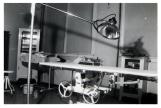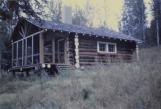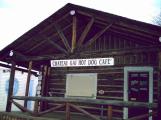11
The Grey Nuns ArriveIn 1938, Sisters Marie-Rose-Anna Henri, Aldéa Roberge, Marie Nadeau, and Eva Bouchard (Cook, Nurse, Local Superior, and Nurse, respectively), arrived at Hôpital Saint Gabriel. They were provided with room and board and wages of $50 annually, though they always returned their wages to the Hospital budget, essentially working without pay. Because the nuns spoke French they gave the hospital a French name (Hôpital Saint Gabriel); however, in order to communicate with patients, doctors, and local staff, the nuns had to learn English through immersion. As it turns out, the doctors learned French at the same time.
12
Sister Marie Nadeau in Fort Smith1937
Fort Smith, Northwest Territories, Canada
 Credits:
Credits:Les Soeurs de la Charité de Montréal, "Soeurs Grises" (The Grey Nuns of Montreal)
13
Building and OpeningBrother Laurant Bruyère directed the lay brothers as they built the new hospital beginning on 28 July 1937. The nuns called it l'Hôpital Saint Gabriel after Bishop Gabriel Breynat's namesake. The new hospital was located on the corner of Franklin Avenue and what is now called Hardin Street. Reverend Father Chouinard, the first Administrator of the hospital, blessed the cornerstone 1 September 1937. Over the course of its construction, the hospital received donations from a number of charities, corporations, and entrepreneurs, including the Catholic Women's League, the Ryan Brothers, the McMurray Salt Plant, Doctor Blais, Northern Transportation, the Hudson's Bay Company, and the Cooper Corporation of Edmonton. Bishop Piché lent and fundraised much of the funding for St. Gabriel's. The hospital received the Stations of the Cross from St. Mary's Hospital in Montreal, and the Sisters inaugurated the Stations into the hospital chapel on 7 February 1938.
The hospital opened on 24 May 1938. However, before this date the hospital had already been used. On 16 May 1938, Rachel Bourque was going into labour. Dr. Malcolm "Rick" McCallum and Sister Marie Nadeau, resident doctor and Superior of the Hospital respectively, decided that Mrs. Bourque and her family should go to the hospital, even though there were no beds yet available. Brother Bruyère quickly assembled a bed and mattress, and they covered it with waxed carpet and thick wrapping paper, as the usual rubber cover was unavailable. Dr. McCallum could not make it to the hospital due to another emergency and he instructed Sister Nadeau to deliver the child herself. At 11 pm, Rachel Bourque gave birth to a baby boy, but passed away herself near midnight.
The boy was one month premature. The Sisters baptized him, and his family named him Joseph Gabriel Gerard Bourque, in part after the hospital. Joseph Bourque survived. The Nuns, in the midst of preparing for the hospital's opening, had delivered their first baby. But they also had to console and counsel his father and nine siblings.
The hospital opened officially on 24 May 1938, and Bishop Breynat blessed it at this time. In its first year, the hospital admitted 152 patients, performed 27 surgical operations, filled 63 prescriptions, applied 657 bandages, and had 4 deaths.
14
Part of the Corpus Christi porcession, with altar made on hospital steps of St. Gabriel's Hospital1941
St. Gabriel's Hospital and outbuildings, Fort McMurray, Alberta, Canada
 Credits:
Credits:Mary O'Coffey
Fort McMurray Historical Society
15
St. Gabriel's Hospital front steps, converted into altar for Corpus Christi1941
St. Gabriel's Hospital and outbuildings, Fort McMurray, Alberta, Canada
 Credits:
Credits:Fort McMurray Historical Society
16
The Hospital BuildingWhen St. Gabriel's Hospital opened, it was a two-building structure with 16 beds and 4 bassinettes. The men's ward was on the main floor while the women's ward was on the second story. The maternity rooms and staff living quarters were also located on the second story. During its early use, the laundry and cooking facilities were kept in the basement; food was ferried up to patients using a manual dumb-waiter. Bedrooms for the sisters and lay nurses were also in the basement. The hospital included a chapel. During its use, the lay brothers performed repairs on the building and ensured that it was heated.
Space was limited in the hospital, but the fact that long-term patients were sent elsewhere eased the load a little. Nonetheless, during influenza epidemics the new hospital did not have enough beds for the number of patients who might check in. During these times, the Nuns and lay staff would give up their own beds for patients. If there were still not enough beds, they would have to double patients up. Due to the limitations on space, Father Lesage sent a letter to the Chamber of Commerce in 1945 requesting a fundraising drive for additional quarters, and in 1948 a separate house was built for nuns and staff. The new space allowed the administration to use their previous bedrooms for patient care. The new building also included a laundry facility, housing a commercial washing machine. This was a great improvement over hand-washing sheets and clothes in the kitchen.
In November 1958, a telephone line was added to the hospital. St. Gabriel's phone number was 2349. In the following year, l'Hôpital Saint Gabriel began receiving government assistance. In 1962, the administration organized another expansion. This time they added an X-ray department, a laboratory, and an operating theatre. Unlike other northern hospitals, St. Gabriel's was modern, well-equipped and well-trained.
The second floor of the hospital had a unique fire escape, according to Betty Golosky, registered nurse, who came to Fort McMurray in 1961. Instead of the typical stairs, there was a slide. It was never used in an emergency, but former nurses suggest that it may have been used for fun on occasion.
17
Aerial view of Fort McMurray in wintercirca 1959
Fort McMurray, Alberta, Canada
 Credits:
Credits:Bob Duncan
Fort McMurray Historical Society
18
Operating room in St. Gabriel's Hospital1939-1960
St. Gabriel's Hospital and outbuildings, Fort McMurray, Alberta, Canada
 Credits:
Credits:Les Soeurs de la Charité de Montréal, "Soeurs Grises" (The Grey Nuns of Montreal)
19
Life in the HospitalNuns were scheduled for ten-hour shifts, but were on call for twenty-four hours a day, since emergencies and births could happen during the day or the night. Their duties included visiting the elderly in their homes, extracting teeth, escorting patients to the hospital, immunizing children, operating the x-ray equipment, performing laboratory testing, and scheduling monthly check-ups. The Sisters cooked for themselves and their patients in the hospital kitchen, but often made enough to give to children from poor families who begged at the door for food. They gardened and they purchased fish and meat from local trappers. The nuns were also responsible for hiring non-religious staff, such as nurses and doctors, to help run the hospital. When possible, they hired people who otherwise would not have work, and they tried to create employment opportunities. For instance, Sister Cardinal refused to buy disposable syringes, as doing so would have put the person who sterilized syringes out of work. This sometimes put the nuns into conflict with hospital staff looking for cheaper or more effective solutions.
Elva Bussieres, local bookkeeper for the Grey Nuns, remembers that "the Nuns were frugal, but with heart. You almost felt guilty about asking for a replacement pen or pencil." When Elva was in the maternity ward as a patient herself, the nuns put flowers on her food tray.
The nuns dealt with a lot of poor patients. Often, new mothers did not have swaddling clothes for their infants, so the nuns collected blankets and baby clothes for them. They also gave away any supplies they did not need. Some nuns had a reputation for giving away things that they did need (see the entry on Sister Superior Lachambre).
L'Hôpital Saint Gabriel was not just a hospital; it was also a convent for the nuns and a place of local worship. Whenever there was a liturgical festival, such as Corpus Christi, the hospital was decorated in honour of it.
Getting to the hospital was technically the patient's responsibility. This could be problematic when the patient was badly injured or in labour. A new policy in the 1950s made hospitalization mandatory for deliveries by first time mothers or mothers giving birth to their fourth child (or more). The new policy made the transportation problem worse. Since women often waited until they went into labour before trying to get to the hospital, the ordeal of childbirth could be preceded by the ordeal of getting to the hospital. Bushplanes, helicopters, and dogsleds all carried pregnant women to St. Gabriel's during its career.
Sister Nadeau reminisced: "Fort McMurray's was very different from all the other hospitals in the north. It served a different kind of people. There were Crees, Montagnais, Métis and more non-Aboriginal people than other northern missions. We had a more balanced diet and we were never in want. There were no long-term tuberculosis patients in our hospital. We had a good supply of medicine and hospital equipment. We had a good supply of water though it was quite a rusty kind of water from a well."
20
Nurses rest in St. Gabriel's Hospital basement bedroomscirca 1941
St. Gabriel's Hospital and outbuildings, Fort McMurray, Alberta, Canada
 Credits:
Credits:Winnie Hutchinson
Fort McMurray Historical Society
21
Men carrying a patient on a stretcher into St. Gabriel's Hospital1939-1948
St. Gabriel's Hospital and outbuildings, Fort McMurray, Alberta, Canada
 Credits:
Credits:Les Soeurs de la Charité de Montréal, "Soeurs Grises" (The Grey Nuns of Montreal)
22
Chateau GaiThe Oblates built the Chateau Gai in 1960 as a residence and 'relaxation centre' for the Grey Nuns, in thanks for their hard work at the Saint Gabriel Hospital and Saint John's Separate School. It was located on the hillside near Hardin Street and Highway 63. The Grey Nuns from the school and the hospital would knit, socialize, or otherwise relax here, and they invited the lay nurses to join them.
Chateau Gai is now preserved in Heritage Park.
23
Chateau Gai, a retreat for the Grey Nuns, at its original location1978
Chateau Gai, Fort McMurray, Alberta, Canada
 Credits:
Credits:Fort McMurray Historical Society
24
Chateau Gai at Heritage Park9 November 2009
Heritage Park, Fort McMurray, Alberta, Canada
 Credits:
Credits:Suzanne Braat